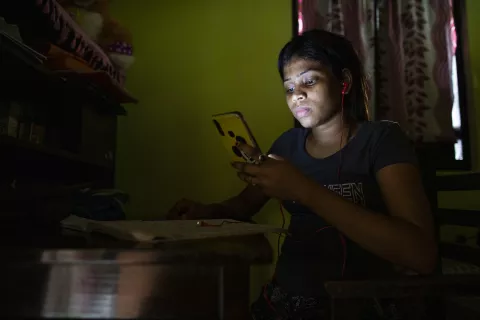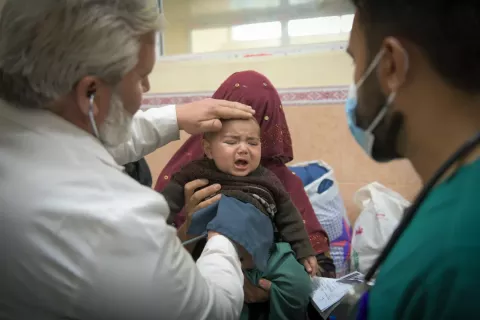Child mask use: Everything you need to know
Practical tips for families in South Asia about children and mask use

The latest evidence shows that children can be infected with COVID-19 and can infect each other and adults. However, they have an extremely low risk of becoming severely unwell from the infection and younger children are much less likely to pass the virus on than older ones.
By wearing face masks in public, even when children feel well, they can help stop the spread of COVID-19 — and protect their families, their communities and themselves.
We spoke to UNICEF Health Expert Srihari Dutta to get his top tips on how children should be wearing masks in their daily lives.
How masks work
COVID-19 spreads through respiratory droplets that people produce when they talk, sing, cough or sneeze. People can have the virus without ever showing symptoms — meaning you, and your children, can be contagious and not even realize it.
Masks work by catching COVID-19 droplets and stopping them from being passed on to other people. They can also protect the wearer from inhaling droplets and becoming infected.
When should children wear masks?
Whether your child should wear a mask depends on a number of factors. Including their age, ability to safely use one and if they are in physical contact with someone who is ill. Across South Asia, some governments have additional requirements on mask use in public and by age. Check your local authority’s guidelines.
WHO and UNICEF advise the following:
Children aged 5 and under

In general, children aged 5 years and under should not wear masks. This advice is based on safety and the overall interests of young children.
Some countries have issued additional local guidance on mask use for very young children. For example, if children are physically close to someone who is ill. If your child under 5 is required to wear a mask, make sure they are always within a direct line of sight to you, so you can supervise.
Children aged 6-11

You should decide whether your child, aged 6-11 years, needs to wear a mask based on:
-
If COVID-19 is widespread in your area.
-
If your child can safely and appropriately use a mask.
-
If you have access to masks and can wash and replace them.
-
If an adult can supervise the child whilst they’re wearing the mask.
-
If your child can understand how to safely put on, take off, and wear a mask.
-
If your child has interactions with other people who are at high risk of developing a serious illness. For example, the elderly and people with health conditions.
You should also consider the potential impact that wearing a mask could have on your individual child’s learning and psychosocial development. Decide this in consultation with your child’s teachers and/or medical providers
Children aged 12 and over

Children aged 12 and over should wear a mask in the same way that adults do.
This means they should wear a mask in all public settings if COVID-19 is widespread in your area and:
-
It is difficult to keep a physical distance of one metre from others (e.g. in crowded public places), or:
-
They are in an indoor public space.
Read more on children and mask use in the latest WHO and UNICEF guidance.
When children do not need to wear masks
Children do not need to wear a mask when:
-
They are at home and no one is sick.
-
They are able to keep a distance of at least 1 meter from other people at all times.
The different types of masks — and which one your child should be wearing
It’s important to understand the different types of masks available and which type your child should be wearing.
Fabric masks

Fabric masks — also known as non-medical masks — are usually made of cotton. They come in many different styles and colours and are washable and reusable. To be effective, they should be made up of a minimum of three layers of fabric.
The World Health Organization (WHO) recommends that most people — including children — wear this type of mask.
Fabric masks should be washed daily (after every use) in hot water with soap or detergent. Wait for your mask to dry completely before wearing it again.
Fabric masks can be expensive, but you can make your own at home. Watch the video below to learn how:
Medical masks

Medical masks — also known as surgical masks — are made of non-woven fabric, are normally three-layered and are designed for healthcare professionals.
Medical masks are in short supply globally because of the pandemic, so the World Health Organisation recommends that only certain groups of people wear this type of mask. This includes medical workers, those over 60 years old, those with underlying health conditions, those caring for someone with COVID-19 and people with symptoms of — or confirmed — COVID-19.
This means children should only wear this type of masks if they have underlying health conditions, have symptoms of — or confirmed — COVID-19, or are around someone who is ill.
Medical masks are not washable or reusable and should be discarded safely after 8 hours of continuous use.
Making sure children are wearing masks correctly
Many masks are designed for adults and don’t fit children properly. Whether you are buying or making a mask for your child, make sure that:
-
Your child’s mask covers their mouth, nose and chin, doesn’t have any gaps on the sides and does not block their vision.
-
Your child can breathe comfortably in the mask while walking briskly and talking.
-
Your child knows to wash their hands with soap and water before putting the mask on and after removing it.
Mask Do’s
Teach your children to continue washing their hands and keeping a distance from others when wearing a mask
A mask alone won’t stop the spread of COVID-19 infection and transmission — they’re only effective when combined with other behaviour.
Make sure you children know that when wearing a mask they should also continue to:
-
Wash their hands with soap and water for at least 20 seconds, or use hand sanitizer – as often as they can.
-
Keep a distance of at least 1 metre from other people and avoid crowded places.
-
Avoid indoor spaces with poor ventilation.
Get a resealable bag to store masks in when you’re out
If you and your family plan to take masks off and reuse them during the day, carry clean resealable bags to store them. Here are some tips:
-
Use a separate bag for each mask in your family.
-
When inserting or removing the mask from the bag, handle it by the elastic loops or ties.
-
Don’t touch the surface of the mask.
-
Remember to wash your hands before putting the mask back on.
Mask Don’ts
Avoid these six common mistakes
Ask your child if they can identify these six common mistakes that people often make when wearing masks. (The answers are below.)
From left to right:
-
Don't pull the mask below your nose.
-
Don't leave your chin exposed.
-
Don't pull the mask below your chin.
-
Don't touch the mask while wearing it.
-
Don't wear a loose mask.
-
Don't wear a dirty, damaged or wet mask.
Don’t share masks
Sharing masks can spread the virus. Make sure your child has their own mask and doesn’t share it with others.
Don’t wear a mask during exercise
Children (and adults) shouldn’t wear masks when playing sports or exercising. Sweat can make masks wet and make it difficult to breathe and easier for germs to grow.
Choose a place for your children to exercise where they can keep a safe physical distance from others, for example at home or outdoors, so a mask isn’t needed.
How to encourage children to wear masks
COVID-19 has upset family life around the world, causing stress, anxiety and sadness. Understandably masks may add to such feelings for many children. For younger children in particular, mask wearing can be confusing and upsetting.
Here are some ideas to help you introduce masks to your family:
-
Be honest and supportive. Recognize that masks aren’t super fun for any of us. But explain how by wearing masks, we can help keep people around us safe, including older people. Wearing a mask shows that we care about each other.
-
Remind them that there are lots of experts working hard to stop COVID-19, but they need our help and that means taking every precaution.
-
Mask wearing is developing a habit, so provide ongoing reminders to children and set an example in your own behaviour.
-
Make masks fun. Try turning choosing a mask or fabric into a fun activity and involve your child as much as possible. Remember, the more your children like the look of their masks, the more likely they are to wear them even when you’re not around.




